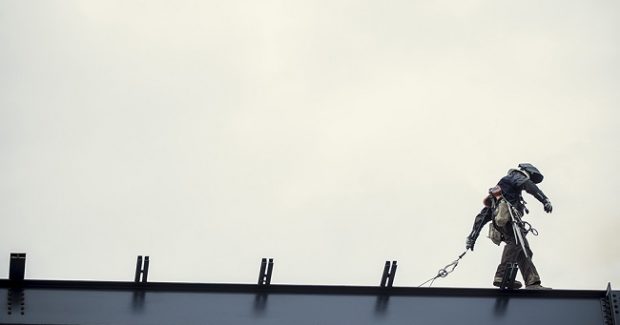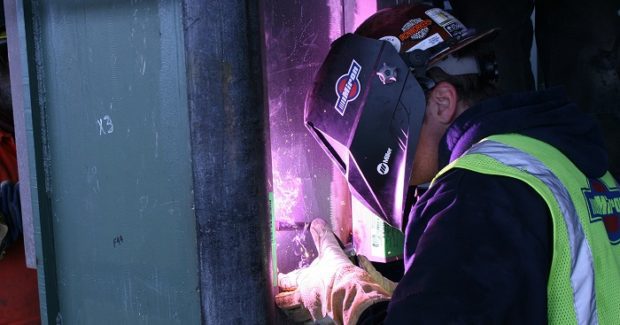How to Improve Productivity and Performance of Field Welded Moment and Column Splice Connections
These best practices for welded moment connections and column splices in the field require an up-front investment of time and money, but considering how much you’re likely leaving on the table, it’s a small price to pay.
Posted: June 28, 2019
It’s no secret that when it comes to structural steel design, it’s always desirable to avoid the more costly and time-consuming field welded connection in favor of a bolted connection. This is even truer when a connection requires a complete joint penetration (CJP) groove weld, most notably found in certain types of moment and column splice connections. The use of welded moment and column splice connections in a project will vary greatly based on several factors, including where the project is located and the type and design of the structure itself. Whether your next project requires many of these types of connections or only a few, these tips can help you save money and maximize your field welding productivity and quality.
TIP 1: USE THE RIGHT SIZE OF EQUIPMENT FOR THE JOB
Welded moment connections and column splices consume a lot of labor hours compared to most other welding jobs on a project. To reduce welding time, one path many contractors and erectors choose is a switch to a larger electrode size. Whether you’re using electric welders, engine-powered welding equipment or a combination of both, it’s important to have the right size machine to get the job done as efficiently as possible the first time. Too often, contractors max out the settings on their welding equipment. While there is nothing fundamentally wrong with this, frequently running at or near the top-end capabilities of a machine means you may not be getting the best weld performance or asset life. Think of your welder as a car. If you need to drive 90 mph, a typical car likely can do that. But if you need to drive 90 mph every day, you would probably make the switch to a higher-performance vehicle. The same is true of welding equipment. Just because a machine can weld at higher ranges doesn’t mean it’s the best option long-term.
For most jobs, a 300 amp to 400 amp machine is probably adequate. If you find yourself welding frequently with wires larger than 5/64 in or needing to perform a lot of carbon arc gouging with electrodes 1/4 in and greater, consider a machine with 500 amps or more.
TIP 2: SWITCH FROM STICK TO FLUX-CORED WELDING
The advantages of self-shielded flux-cored welding over stick welding may seem obvious to some, but there are many construction and erection companies still welding all of their CJP multi-pass welds with the stick (shielded metal arc welding or SMAW) process. Stick welding is great for many applications, but switching to a self-shielded flux-cored wire for projects requiring larger multi-pass welds offers several benefits:
- Deposition rates: Compared to the most commonly used 1/8 in 7018 stick electrodes, which typically only yield deposition rates of 3 lb/hr or less, a comparable all-position flux-cored wire can double or even triple this production.
- Deposition efficiency: This refers to the percentage of the electrode that actually makes it into the final weld. Have you ever considered how much money you’re throwing on the ground? After every weld, whether the electrode is fully consumed or only partially used, the remaining electrode stub usually ends up in the same place – on the ground. This creates a mess to be cleaned up and takes money out of your pocket. Using a 1/8 in 7018 stick electrode as an example, you’d be lucky to achieve 70 percent efficiency after accounting for flux and stub loss. Switching to a flux-cored wire can deliver efficiency gains of 10 percent or greater, due to the increased ability to feed and deposit molten metal into the weld joint, coupled with the fact that welders can start and stop at any time without consumable waste.
TIP 3: CHOOSE THE RIGHT FLUX-CORED WIRE
When it comes to structural welding with a self-shielded flux-cored wire, many contractors use what is known as a T-8 wire. These wires, which run on direct current electrode negative (DCEN) polarity, are versatile all-position wires that produce good low-temperature impacts and can be used for multi-pass welds. While the appeal of using a single wire for an entire project is understandable, consider switching to a T-6 wire for flat or horizontal welds like those found in a welded column splice. These wires run direct current electrode positive (DCEP) polarity and typically yield substantially higher deposition rates than a T-8 wire. They also provide good penetration and typically produce very good low-temperature impacts as well.
TIP 4: SPEND LESS TIME WALKING
Recent studies have shown that on average, a typical ironworker makes four trips back to their machine to make adjustments during the day. Multiply that wasted time by a five-day work week and 50-week working year. Assuming each round-trip takes approximately 15 minutes and using $45/hr as an estimate of what it costs a contractor to employ an ironworker, that’s an annual productivity loss of $11,250 – just paying for a welder to walk back and forth to make adjustments at the power source. Whether the cost in your operation is half of this or twice as much, when you multiply it against all the welders on the payroll, it adds up to a significant waste of money and loss in productivity.
To address this jobsite challenge, there have been some improvements in the development of advanced remote control technologies for welding equipment, such as our ArcReach® technology, for example. Using only standard welding cables and a compatible power source, a digital ArcReach remote box or wire feeder accessory plugs right in line with either your stick stinger or flux-cored gun. From these accessories, you can not only adjust amperage, voltage and other arc control settings, but you can also see and adjust welding programs and processes right at the weld joint. This eliminates the need to walk back to the power source or run a separate bulky and easily damaged corded analog remote. Additionally, on some of the latest power sources, the machine will automatically compensate for any voltage drop on the welding cable, so whatever you preset on the machine is exactly what you’ll get at the arc. There is no need to dial or step-in the correct parameters yourself.
FINAL THOUGHTS
If it’s been a while since you’ve made changes or improvements to your welding operation, consider evaluating some of the new solutions on the market today. Implementing these best practices for welded moment connections and column splices in the field requires an up-front investment of time and money, but considering how much you’re likely leaving on the table, it’s a small price to pay.



















